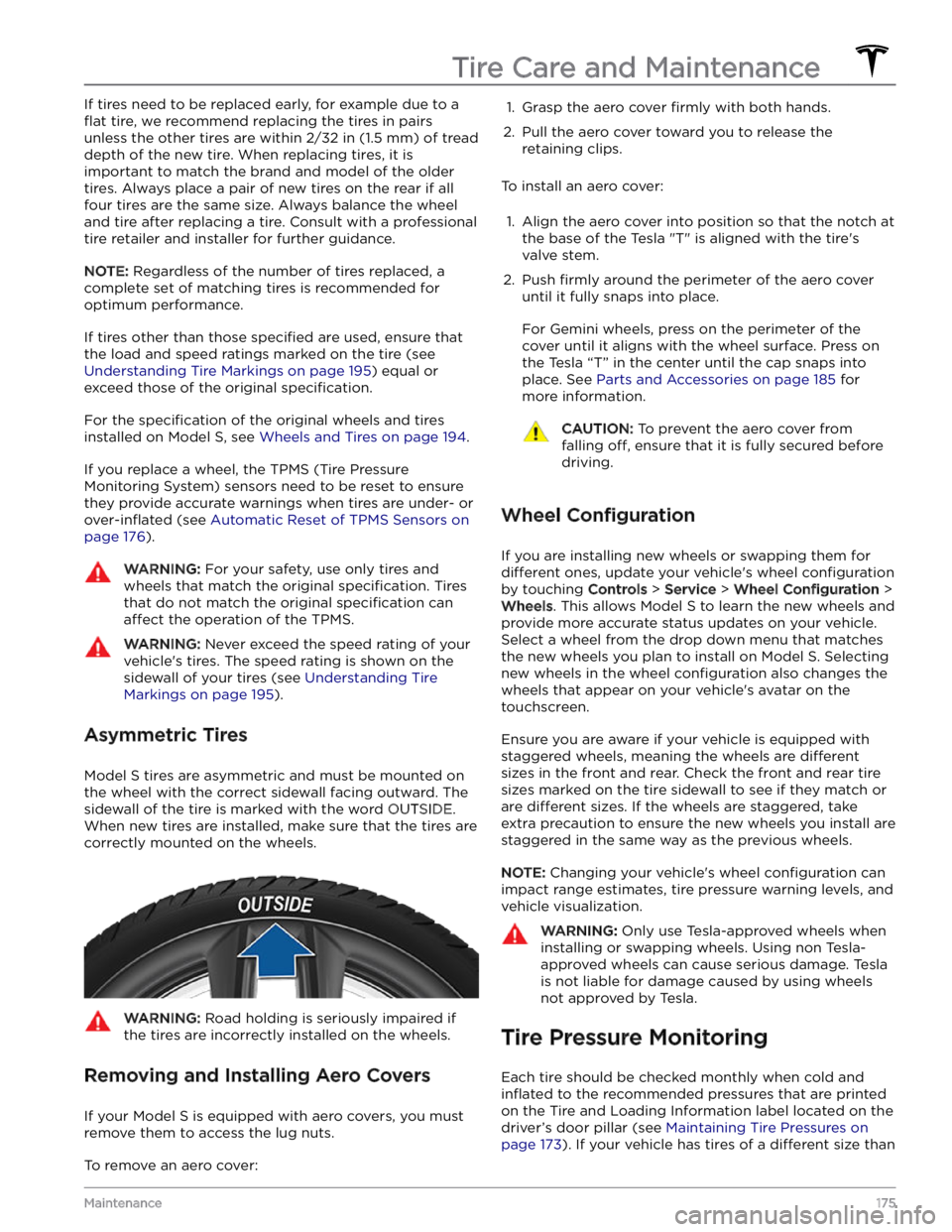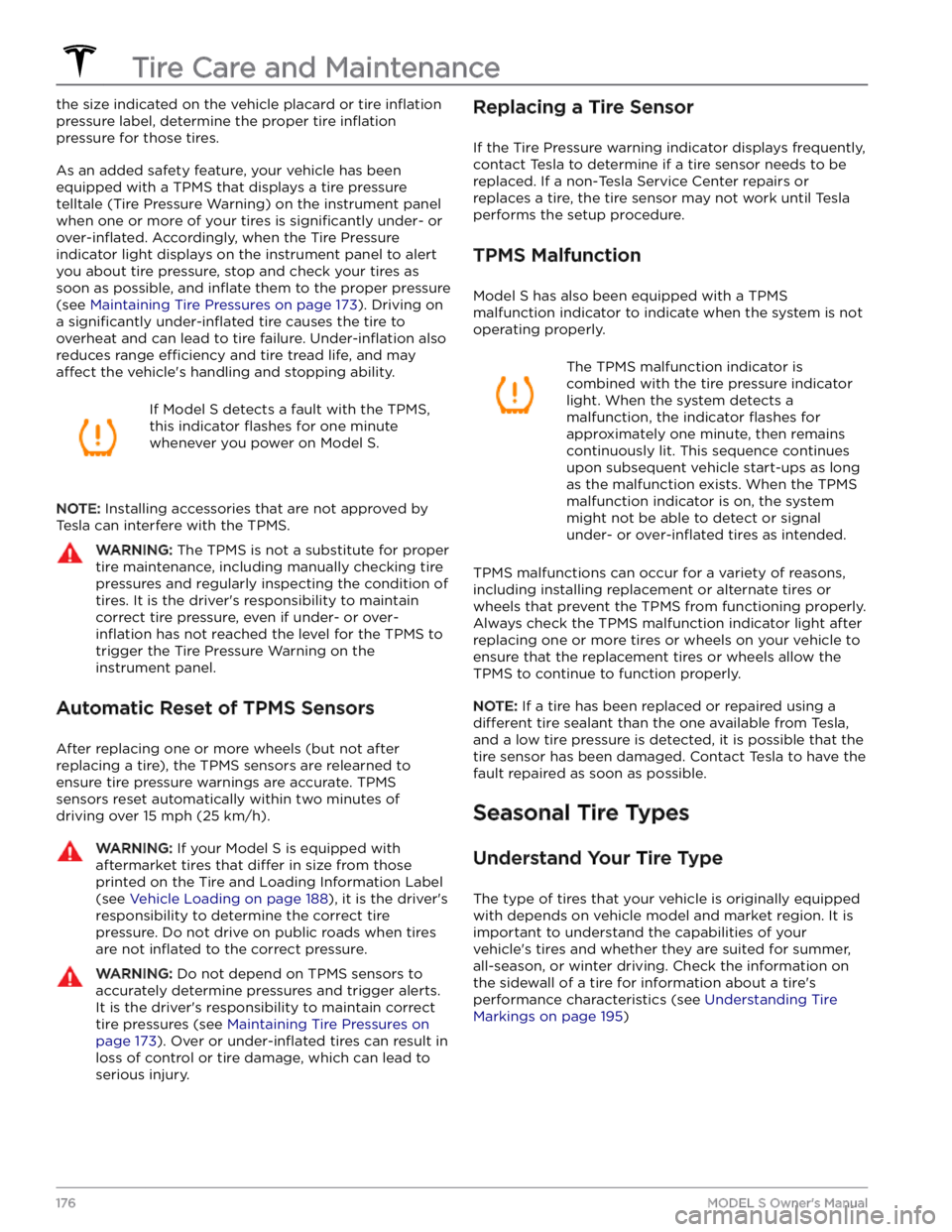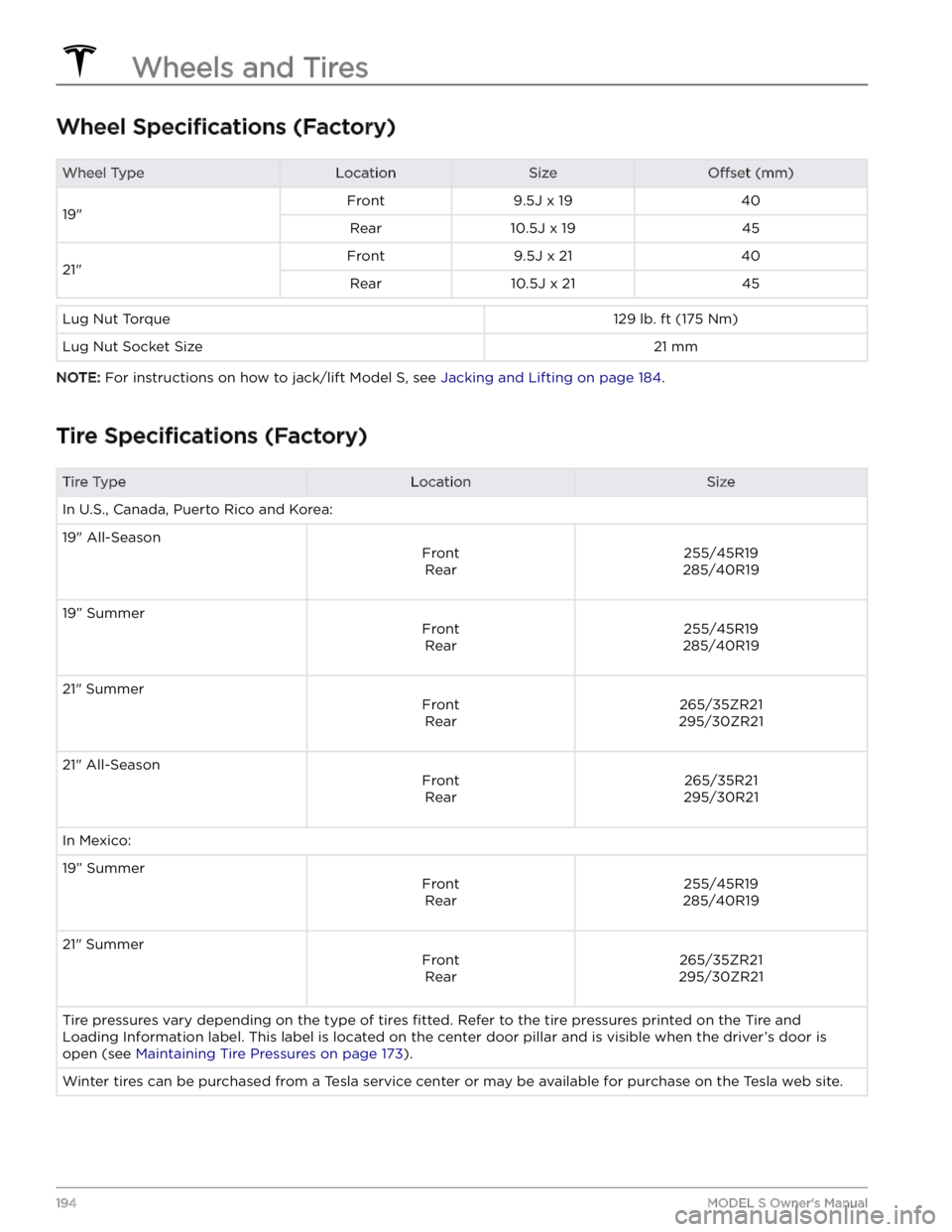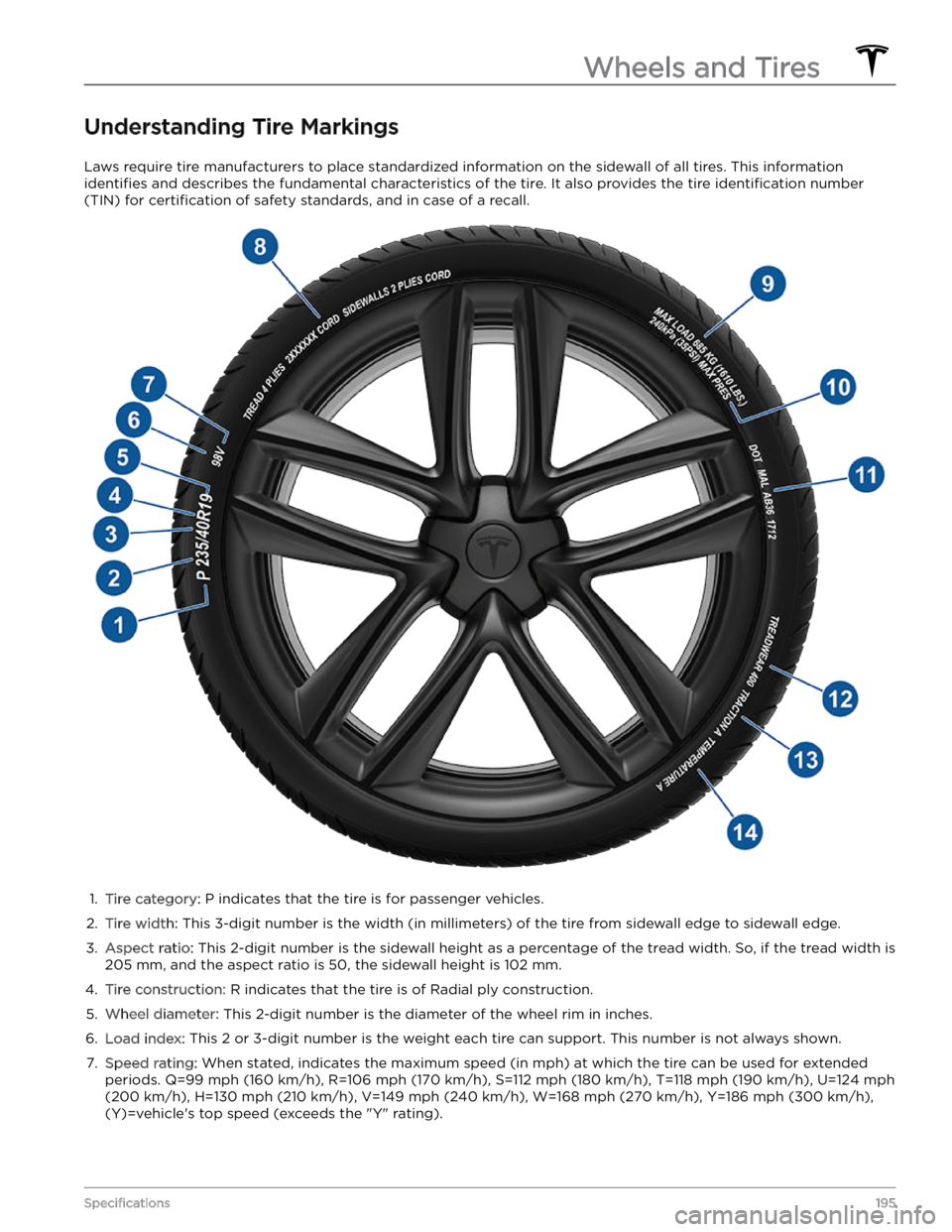Tire TESLA MODEL S 2023 User Guide
[x] Cancel search | Manufacturer: TESLA, Model Year: 2023, Model line: MODEL S, Model: TESLA MODEL S 2023Pages: 276, PDF Size: 7.88 MB
Page 176 of 276

Tire Wear
Adequate tread depth is important for proper tire
performance. Tires with a tread depth less than
4/32”
(3 mm) are more likely to hydroplane in wet conditions
and should not be used. Tires with a tread depth less than
5/32” (4 mm) do not perform well in snow and
slush and should not be used when driving in winter conditions.
Model S is originally fitted with tires that have wear
indicators molded into the tread pattern. When the
tread has been worn down to
4/32” (3 mm), the
indicators start to appear at the surface of the tread pattern, producing the
effect of a continuous band of
rubber across the width of the tire. For optimal performance and safety, Tesla recommends replacing tires before the wear indicators are visible.
To improve vehicle handling characteristics and minimize hydroplaning in wet conditions, put tires with the most tread on the rear of the car.
Tire Rotation, Balance, and Wheel
Alignment
Tesla recommends rotating the tires every 6,250 miles
(10,000 km) or if tread depth difference is 2/32 in (1.5
mm) or greater, whichever comes first.
Tire rotation is an essential part of tire maintenance. It helps maintain an even treadwear pattern which enhances the tire
Page 177 of 276

If tires need to be replaced early, for example due to a
flat tire, we recommend replacing the tires in pairs
unless the other tires are within
2/32 in (1.5 mm) of tread
depth of the new tire. When replacing tires, it is important to match the brand and model of the older
tires. Always place a pair of new tires on the rear if all four tires are the same size. Always balance the wheel and tire after replacing a tire. Consult with a professional tire retailer and installer for further guidance.
NOTE: Regardless of the number of tires replaced, a
complete set of matching tires is recommended for
optimum performance.
If tires other than those specified are used, ensure that
the load and speed ratings marked on the tire
(see
Understanding Tire Markings on page 195) equal or
exceed those of the original
specification.
For the specification of the original wheels and tires
installed on
Model S, see Wheels and Tires on page 194.
If you replace a wheel, the TPMS (Tire Pressure Monitoring System) sensors need to be reset to ensure they provide accurate warnings when tires are under-
or
over-inflated (see Automatic Reset of TPMS Sensors on
page 176).
WARNING: For your safety, use only tires and
wheels that match the original specification. Tires
that do not match the original specification can
affect the operation of the TPMS.
WARNING: Never exceed the speed rating of your
vehicle
Page 178 of 276

the size indicated on the vehicle placard or tire inflation
pressure label, determine the proper tire inflation
pressure for those tires.
As an added safety feature, your vehicle has been
equipped with a TPMS that displays a tire pressure telltale (Tire Pressure Warning) on the
instrument panel
when one or more of your tires is significantly under- or
over-inflated. Accordingly, when the Tire Pressure
indicator light displays on the
instrument panel to alert
you about tire pressure, stop and check your tires as soon as possible, and
inflate them to the proper pressure
(see
Maintaining Tire Pressures on page 173). Driving on
a
significantly under-inflated tire causes the tire to
overheat and can lead to tire failure.
Under-inflation also
reduces range
efficiency and tire tread life, and may
affect the vehicle
Page 179 of 276

Summer and All-Season Tires
Summer tires and all season tires are designed for
maximum dry and wet road performance but are not designed to perform well in winter conditions. All-
season tires are designed to provide adequate traction in most conditions year-round, but may not provide the
same level of traction as winter tires in snowy or icy
conditions. All-season tires can be
identified by “ALL
SEASON" and/or "M+S” (mud and snow) on the tire sidewall.
If driving in cold temperatures or on roads where snow
or ice may be present, Tesla recommends using winter tires. If not equipped with winter tires, contact Tesla for winter tire recommendations.
WARNING: In cold temperatures or on snow or ice,
summer and all-season tires do not provide
adequate traction. Selecting and installing the
appropriate tires for winter conditions is important
to ensure the safety and optimum performance of
your Model S.
Winter Tires
Use winter tires to increase traction in snowy or icy
conditions. When installing winter tires, always install a complete set of four tires at the same time. Winter tires
must be the same diameter, brand, construction and
tread pattern on all four wheels. Contact Tesla for winter tire recommendations.
Winter tires can be identified by a
mountain/snowflake symbol on the tire
Page 191 of 276

Mexico:
CAUTION: To prevent damage, never load Model S
so that it is heavier than GVWR or exceeds the
individual GAWR weights.
Roof Racks
A Model S equipped with a glass roof can carry up to 165 lbs (75 kg) using a Tesla-approved roof rack
(see
Parts and Accessories on page 185).
Calculating Load Limits
1.
Locate the statement “The combined weight of occupants and cargo should never exceed XXX lbs or
XXX kg” on the “Tire and Loading Information” label.
2.
Determine the combined weight of all occupants that will ride in the vehicle.
3.
Subtract the combined weight of the occupants from XXX lbs or XXX kg (see Step 1).
4.
The resulting figure equals the available cargo load
capacity. For example, if the “XXX” amount equals
1400 lbs (635 kg) and there will be
five 150 lb (68 kg)
passengers in the vehicle, the amount of available
cargo capacity is 650 lbs (1400
Page 196 of 276

Wheel Specifications (Factory)
Wheel TypeLocationSizeOffset (mm)19"Front9.5J x 1940Rear10.5J x 194521"Front9.5J x 2140Rear10.5J x 2145Lug Nut Torque129 lb. ft (175 Nm)Lug Nut Socket Size21 mm
NOTE: For instructions on how to jack/lift Model S, see Jacking and Lifting on page 184.
Tire Specifications (Factory)
Tire TypeLocationSizeIn U.S., Canada, Puerto Rico and Korea:19" All-Season
FrontRear255/45R19
285/40R19
19” Summer
Front Rear255/45R19
285/40R19
21" Summer
Front Rear265/35ZR21
295/30ZR21
21" All-Season
Front Rear265/35R21
295/30R21
In Mexico:19” Summer
Front Rear255/45R19
285/40R19
21" Summer
Front Rear265/35ZR21
295/30ZR21
Tire pressures vary depending on the type of tires fitted. Refer to the tire pressures printed on the Tire and
Loading Information label. This label is located on the center door pillar and is visible when the driver
Page 197 of 276

Understanding Tire Markings
Laws require tire manufacturers to place standardized information on the sidewall of all tires. This information
identifies and describes the fundamental characteristics of the tire. It also provides the tire identification number
(TIN) for certification of safety standards, and in case of a recall.
1.
Tire category: P indicates that the tire is for passenger vehicles.
2.
Tire width: This 3-digit number is the width (in millimeters) of the tire from sidewall edge to sidewall edge.
3.
Aspect ratio: This 2-digit number is the sidewall height as a percentage of the tread width. So, if the tread width is
205 mm, and the aspect ratio is 50, the sidewall height is 102 mm.
4.
Tire construction: R indicates that the tire is of Radial ply construction.
5.
Wheel diameter: This 2-digit number is the diameter of the wheel rim in inches.
6.
Load index: This 2 or 3-digit number is the weight each tire can support. This number is not always shown.
7.
Speed rating: When stated, indicates the maximum speed (in mph) at which the tire can be used for extended
periods. Q=99 mph (160 km/h), R=106 mph (170 km/h), S=112 mph (180 km/h), T=118 mph (190 km/h), U=124 mph (200 km/h), H=130 mph (210 km/h), V=149 mph (240 km/h), W=168 mph (270 km/h), Y=186 mph (300 km/h),
(Y)=vehicle
Page 198 of 276

8. Tire composition and materials: The number of plies in both the tread area and the sidewall area indicates how
many layers of rubber coated material make up the structure of the tire. Information is also provided on the type
of materials used.9.
Maximum tire load: The maximum load which can be carried by the tire.
10.
Maximum permissible inflation pressure: This pressure should not be used for normal driving.
11.
U.S. DOT Tire Identification Number (TIN): Begins with the letters DOT and indicates that the tire meets all federal
standards. The next 2 digits/letters represent the plant code where it was manufactured, and the last 4 digits represent the week and year of manufacture. For example, the number 1712 is used to represent the 17th week of 2012. The other numbers are marketing codes used at the manufacturer
Page 199 of 276

Uniform Tire Quality Grading
The following information relates to the tire grading system developed by the National Highway Traffic Safety
Administration (NHTSA), which grades tires by tread wear, traction and temperature performance. Tires that have
deep tread, and winter tires, are exempt from these marking requirements.
Where applicable, quality grades are found on the tire
Page 200 of 276

Tire and Loading Glossaries
General Wheel and Tire Terms
Accessory WeightThe combined weight (in excess of those items replaced) of items available as factory
installed equipment.BeadThe inner edge of a tire that is shaped to fit to the rim and form an air tight seal. The
bead is constructed of steel wires which are wrapped, or reinforced, by the ply cords.Cold Tire PressureThe air pressure in a tire that has been standing in excess of three hours, or driven for less than one mile.Curb WeightThe weight of a standard vehicle, including any optional equipment fitted, and with the
correct
fluid levels.
Gross Vehicle WeightThe maximum permissible weight of a vehicle with driver, passengers, load, luggage, and
equipment.kPa (kilo pascal)A metric unit used to measure pressure. One kilo pascal equals approximately 0.145 psi.Maximum Inflation
Pressure
The maximum pressure to which the tire should be inflated. This pressure is given on the
tire side wall in psi (lbf/in2).
CAUTION: This pressure marked on the tire is the maximum allowed by the tire
manufacturer. It is not the pressure Tesla recommends using for Model S.
Maximum Loaded
Vehicle WeightThe sum of curb weight, accessory weight, vehicle capacity weight, and production options weight.Production Options
WeightThe combined weight of options installed which weigh in excess of 3 lb (1.4 kg) more
than the standard items that they replaced, and are not already considered in curb or
accessory weights.PSI (lbf/in2)Pounds per square inch (the unit used to measure tire pressure).Recommended Tire
Inflation Pressure
Tire inflation pressure, established by Tesla, which is based on the type of tires that are
mounted on the vehicle at the factory. This information can be found on the Tire
and
Loading Information label located on the door pillar.
RimThe metal support for a tire, or tire and tube, upon which the tire beads are seated.Vehicle Capacity
WeightThe number of seats multiplied by 150 lbs (68 kg) plus the rated amount of load/luggage.
Load Carrying Definitions
Normal occupant weight68 kilograms (150 lbs) times the number of occupants specified in the second column
of the tables for calculating load limits (see
Vehicle Loading on page 188).
Occupant distributionDistribution of occupants in a vehicle.Passenger car tireA tire intended for use on passenger cars, multipurpose passenger vehicles, and trucks, that have a
Gross Vehicle Weight Rating (GVWR) of 10,000 lbs (4536 kg) or
less.
Rim diameterNominal diameter of the bead seat.Rim size designationRim diameter and width.Rim type designationThe manufacturing industry